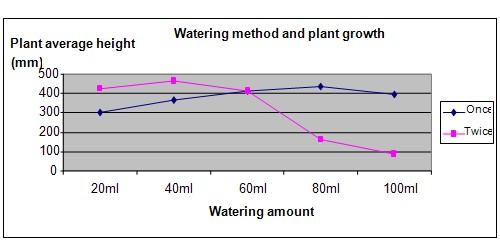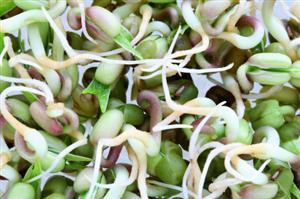| Complexity level: | 4 |
| Project cost ($): | 20 |
| Time required: | Preparation will take approximately one day, while observation and recording of data will require ten days |
| Material availability: | Easily found |
| Safety concerns: | Basic safety requirements |
Hypothesis
The greater the amount of water, the faster the growth.
Overview
Water and plant growth
Water sustains life, and is therefore important to all living organisms on our planet. These include plants, which will wilt, become dry and die in the absence water.
The actual amount of water needed by a plant to grow will depend on the type of soil used, the size of the pot, the species of the plant and the age of the plant. A soil’s water retention properties will determine the amount of watering required. Soil that is poor in retaining water will require more frequent watering, whereas soil that has good water retention properties will require less frequent watering. The size of the pot is also important, as it determines the amount of water that can be added to maintain the required soil moisture.
The size and number of leaves, together with the size of a plant’s stem, will give us an estimate on the appropriate amount of water that a plant needs. Young plants tend to require more frequent watering to maintain the moisture near the surface of the soil, as its roots have not grown deep enough and will therefore only be near the surface of soil. On the other hand, an older plant will require less frequent watering .
Scientific Terms
Materials
Materials required for this science fair project:
- 1 packet of radish seeds
- 10 small plastic pots
- Soil required to fill the 10 pots
- Tap water
- 1 measuring cylinder
- Ruler (1 meter)
- 1 marker
Procedure
1. The independent variable in this science fair project is the amount of water used every day– 20ml, 40ml, 60ml, 80ml and 100ml once a day or twice a day. The dependent variable is the height of the mung bean sprouts, which is determined by measuring the average height of the plants in each test group. The constants (control variables) are the environment that the plants are kept in (temperature, humidity, light, etc), the species of plant used, the size of the pot and the type of soil.
2. Fill the ten pots with the same amount of soil , and place ten mung beans in each pot. (More than ten mung beans seeds can be placed in each pot to act as backup in case some of the beans do not germinate. Remove any unwanted plants once germination has occurred).
3. Use the marker to label the ten pots as “once” or “twice”, followed by one of the following measurement: 20 ml, 40 ml, 60 ml, 80 ml or 100 ml.
4. Water the pots labeled “once” once a day, and the pots labeled “twice” two times a day, using the amount of water indicated on the pot. Repeat this procedure for the next ten days.
5. Measure the heights of the plants on the 10th day. Calculate the average height of the radish plants in each pot by totaling the heights and dividing it by the number of plants. Record the average height in the table given below.

Results
Plants watered with 40 ml of water twice a day were observed to be the tallest after ten days, followed by plants watered with 80 ml of water once a day.
Number of times watered per day Effect of different amount of water on the height of mung beans growth (mm)
| Number of times watered per day | Effect of different amount of water on the height of mung beans growth (mm) | ||||
| 20 ml | 40 ml | 60 ml | 80 ml | 100 ml | |
| Once | 305 | 365 | 415 | 435 | 395 |
| Twice | 425 | 465 | 415 | 160 | 85 |
The graph below represents the results of our science experiment.

Conclusion
The experimental data and analyzed results support our hypothesis that the greater the amount of water, the faster the growth rate, but only up to a certain point. If too much water is given to the plants, their growth rate fell.
Research shows that too much water in the soil is detrimental to plant growth, as wet soil tends to cover a plant’s root with water and therefore deprive it of oxygen. This cause the roots to rot will eventually lead to the death of the plant.
Also consider
What would happen if this science fair project was repeated using other species of plants such as corn and green peas?
The experiment can be repeated by placing the pots under a shade or directly outside under the sun.
References
How to water plants - http://home.howstuffworks.com/how-to-water-plants.htm
How to water a plant – how much water should I give my plant - http://www.gardeningknowhow.com/indoor/how-to-water-a-plant.htm

